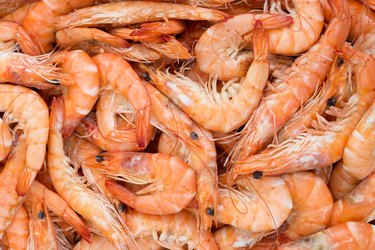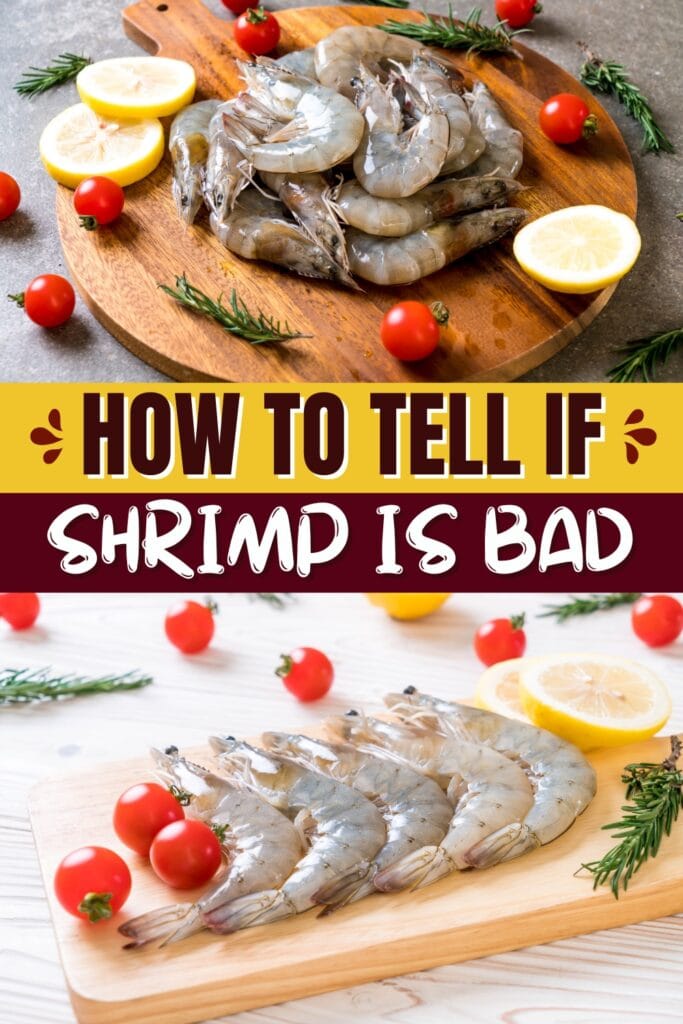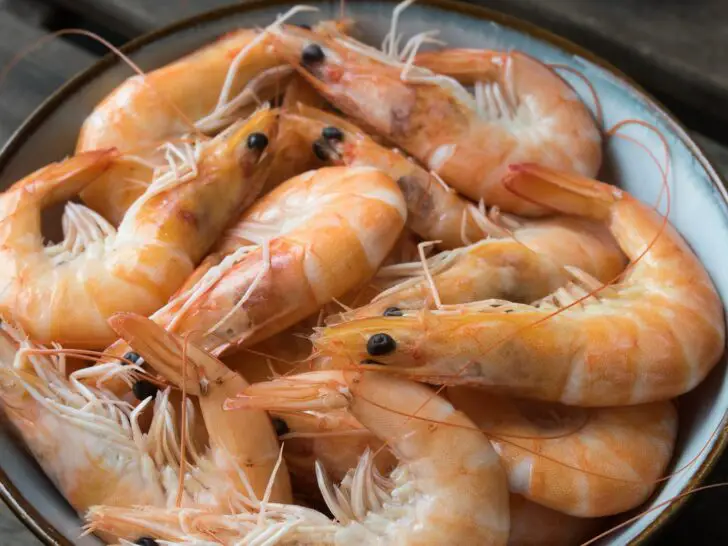Signs Of Spoiled Shrimp

When inspecting shrimp for spoilage, there are several visible signs to look out for. Spoiled shrimp may have an unpleasant odor and unusual discoloration, such as gray or black spots. Changes in texture, such as sliminess or a sticky coating, can also indicate spoilage. Additionally, any visible mold growth on the shrimp or damage to the shell should not be ignored. These signs are important to consider before consuming shrimp to ensure food safety and prevent the risk of foodborne illnesses. Remember to always trust your senses and discard any shrimp that shows signs of spoilage.
Unpleasant Odor And Discoloration
When inspecting shrimp for spoilage, one of the key signs to look out for is an unpleasant odor and discoloration. Spoiled shrimp can emit a strong, rotten smell that is distinct and unpleasant. Additionally, the color of the shrimp may change, with gray or black spots appearing on the surface. Discoloration can indicate bacterial or fungal growth, which can affect the taste and safety of the shrimp. It is important to trust your senses and discard any shrimp that have an off-putting odor or abnormal coloring to ensure food safety.
Changes In Texture And Slime Coating
Changes in texture and the presence of a slimy coating are clear signs of spoiled shrimp. When a shrimp is no longer fresh, its texture can change from firm to mushy or slimy. Cooked shrimp should have a firm texture, and any deviation from that can indicate spoilage. Additionally, if the shrimp is covered in a slimy coating or has a thin film on its surface, it is a clear indication that it has gone bad. These changes in texture and the presence of slime are important factors to consider when assessing the quality of shrimp.
Detecting Spoiled Shrimp By Appearance

When it comes to detecting spoiled shrimp, appearance can be a helpful indicator. One sign of spoiled shrimp is abnormal color and the presence of dark spots. Fresh shrimp should have a uniform color without any discoloration or strange marks. Another visual cue is shell damage, such as cracks or holes, which can indicate that the shrimp is no longer fresh. Additionally, visible mold growth on the shrimp is a clear indication of spoilage. By paying attention to the appearance of your shrimp, you can quickly identify if it has gone bad and avoid consuming it.
Abnormal Color And Dark Spots
When examining shrimp for spoilage, one should look out for any abnormal color or dark spots on the shell. Fresh shrimp should have a uniform and vibrant color, so any discoloration is a red flag. Dark spots can indicate bacterial growth and spoilage. These spots may appear black or brown and should not be ignored. If you notice any abnormal color or dark spots on your shrimp, it is best to discard them as they may pose a risk of foodborne illnesses.
Shell Damage And Visible Mold
Shell damage and visible mold are clear indications of spoiled shrimp. If you notice any cracks, chips, or breaks in the shell, it is likely that bacteria have penetrated the protective barrier, leading to spoilage. Additionally, the presence of visible mold on the shell is a definite sign of shrimp that should be discarded. Mold growth can occur due to improper storage or contamination, and consuming shrimp with mold can pose health risks. In such cases, it is best to err on the side of caution and discard the shrimp to ensure food safety.
The Role Of Smell In Identifying Spoiled Shrimp

The sense of smell plays a crucial role in identifying spoiled shrimp. When shrimp goes bad, it often emits a strong and unpleasant odor. Rotten or ammonia-like smells are clear indications that the shrimp is no longer safe to consume. Additionally, a foul or fishy smell can also point to spoilage. If you detect any of these odors when inspecting your shrimp, it’s best to discard it to avoid the risk of foodborne illnesses. Trust your nose and prioritize food safety when dealing with shrimp.
Rotten Or Ammonia-like Odor
A clear sign of spoiled shrimp is the presence of a rotten or ammonia-like odor. This pungent smell is a strong indication that the shrimp is no longer safe to consume. The odor is caused by the breakdown of proteins in the shrimp, which produce compounds like ammonia and amines. Trust your sense of smell and if you detect this unpleasant odor, it is best to discard the shrimp immediately. Ignoring this warning sign may lead to foodborne illnesses and serious health consequences. Ensure your safety by prioritizing proper food handling and disposal.
Foul Or Fishy Smell
A foul or fishy smell is another indication of spoiled shrimp. Fresh shrimp should have a mild, slightly salty aroma reminiscent of the sea. However, if the shrimp emits a strong, pungent fishy smell, it is a sign that it has gone bad. This odor is caused by the breakdown of proteins in the shrimp, indicating bacterial growth and decomposition. It is important to trust your sense of smell and discard shrimp with a foul or fishy odor to avoid the risk of foodborne illnesses. Proper handling and disposal of spoiled shrimp is crucial for ensuring food safety.
Checking Shrimp For Spoilage Through Touch

When inspecting shrimp for spoilage, touching the shrimp can provide valuable information about its condition. One indication of spoiled shrimp is a slimy or sticky texture. Fresh shrimp should feel firm and slightly springy to the touch. If the shrimp feels slimy or mushy, it is a sign that it has likely spoiled and should be discarded. This sliminess is caused by bacterial growth and decomposition. Trust your sense of touch and discard shrimp that does not have the proper texture to avoid any potential foodborne illnesses. Proper handling and disposal of spoiled shrimp is essential for food safety.
Slimy Or Sticky Texture
A slimy or sticky texture is a clear indication that shrimp has spoiled and should not be consumed. Fresh shrimp should feel firm and slightly springy to the touch. If the shrimp feels slimy or mushy, it is a sign of bacterial growth and decomposition. This sliminess is caused by the breakdown of proteins in the shrimp. Trust your sense of touch and discard any shrimp that does not have the proper texture to ensure food safety. Proper handling and disposal of spoiled shrimp are essential to prevent any potential foodborne illnesses.
Soft Or Mushy Consistency
When examining shrimp for spoilage, another important factor to consider is the consistency of the flesh. Fresh shrimp should have a firm and tender texture. However, if the shrimp feels soft or mushy to the touch, it is a clear indication of spoilage. This change in consistency is often caused by bacterial growth and the breakdown of proteins in the shrimp. It is crucial to discard any shrimp with a soft or mushy texture to prevent the risk of foodborne illnesses. Proper handling and disposal are essential to maintaining food safety.
Safety Considerations When Dealing With Spoiled Shrimp

When encountering spoiled shrimp, it is crucial to prioritize food safety and take appropriate measures. Discard any shrimp that show signs of spoilage, such as an unpleasant odor, discoloration, or changes in texture. Follow proper food safety guidelines when handling and storing shrimp to minimize the risk of contamination. It is important to remember that consuming spoiled shrimp can lead to foodborne illnesses. Do not take chances with your health – always inspect shrimp carefully and dispose of any that appear spoiled. Proper handling and disposal are essential for maintaining food safety.
Food Safety Guidelines And Proper Handling
Following food safety guidelines and proper handling practices is essential when dealing with shrimp to prevent contamination and ensure food safety. Here are some important guidelines to keep in mind:
- Purchase shrimp from reputable sources: Buy shrimp from trusted suppliers or reputable grocery stores to minimize the risk of purchasing spoiled or contaminated shrimp.
- Store shrimp properly: Keep shrimp refrigerated at or below 40°F (4°C) to prevent bacterial growth. It is recommended to consume shrimp within two days of purchase.
- Thaw shrimp safely: If using frozen shrimp, thaw them in the refrigerator overnight or under cold running water. Avoid thawing shrimp at room temperature, as it can lead to bacterial growth.
- Cook shrimp thoroughly: Shrimp should be cooked until they reach an internal temperature of 145°F (63°C) to kill any potential bacteria or parasites. Avoid consuming undercooked shrimp.
- Practice good hygiene: Wash your hands thoroughly with soap and water before and after handling shrimp. Additionally, ensure that cutting boards, knives, and other utensils used for shrimp are properly cleaned and sanitized.
By following these food safety guidelines and practicing proper handling techniques, you can minimize the risk of foodborne illnesses and enjoy safely prepared shrimp.
Risk Of Foodborne Illnesses
Consuming spoiled shrimp can pose a significant risk of foodborne illnesses. Shrimp are prone to bacterial growth, and when they become spoiled, harmful bacteria such as Vibrio parahaemolyticus and Salmonella can multiply. These bacteria can cause severe gastrointestinal symptoms, including stomach cramps, diarrhea, and vomiting. Moreover, spoiled shrimp may also harbor parasites, such as roundworms or tapeworms, which can lead to parasitic infections. Therefore, it is crucial to ensure the freshness and quality of shrimp before consuming them to minimize the risk of foodborne illnesses.
Conclusion

In conclusion, being able to detect spoiled shrimp is crucial for ensuring food safety and preventing the risk of foodborne illnesses. By paying attention to signs such as unpleasant odor, discoloration, changes in texture, and slime coating, individuals can quickly identify if shrimp has gone bad. It is important to prioritize proper storage and handling techniques to maintain the freshness of shrimp. Additionally, following food safety guidelines and cooking shrimp thoroughly can further reduce the risk of consuming spoiled seafood. By using our senses and being vigilant, we can safely enjoy delicious and fresh shrimp dishes.
Importance Of Inspecting Shrimp For Spoilage
Inspecting shrimp for spoilage is of utmost importance to ensure food safety and prevent potential health risks. By identifying signs of spoilage, such as unpleasant odor, discoloration, changes in texture, and slime coating, individuals can avoid consuming contaminated seafood. Spoiled shrimp can contain harmful bacteria or toxins, which can lead to foodborne illnesses if consumed. Regularly checking shrimp for freshness and discarding any spoiled pieces is crucial in maintaining a healthy and safe diet. Prioritizing proper inspection and handling techniques allows individuals to enjoy delicious shrimp dishes without compromising their well-being.
Tips For Storing And Consuming Shrimp Safely
To ensure the safe storage and consumption of shrimp, follow these tips:
- Refrigeration: Store fresh shrimp in the refrigerator at a temperature below 40°F (4°C). Use airtight containers or sealed bags to prevent cross-contamination.
- Freezing: If you’re not planning to consume the shrimp immediately, freeze them. Place them in freezer-safe bags or containers, removing as much air as possible to prevent freezer burn.
- Thawing: When thawing frozen shrimp, do so in the refrigerator overnight or under cold running water. Avoid leaving them at room temperature for extended periods to prevent bacterial growth.
- Cooking thoroughly: Cook shrimp thoroughly until they turn opaque and reach an internal temperature of 145°F (63°C) to kill any harmful bacteria.
By following these storage and cooking guidelines, you can enjoy delicious and safe shrimp dishes without any worries.
FAQ About How To Tell If Shrimp Is Bad: Detecting Spoilage
Q: Why is it important to know if shrimp has gone bad?
A: Consuming spoiled shrimp can lead to food poisoning, which can cause various health issues such as diarrhea, vomiting, and stomach cramps.
Q: How can one determine if shrimp has spoiled?
A: One can check for signs like a fishy or ammonia-like smell, slimy texture, or discoloration of the shrimp. Additionally, if the shrimp has an off taste, it is likely spoiled.
Q: What should be done if bad shrimp is detected?
A: It is important to discard any shrimp that shows signs of spoilage immediately to prevent any risk of foodborne illness. Do not consume or cook spoiled shrimp.
Q: Can spoiled shrimp be salvaged by cooking it thoroughly?
A: No, cooking spoiled shrimp will not make it safe to eat. Once shrimp has gone bad, it should be disposed of properly to avoid food poisoning.
Q: Is it safe to consume shrimp that has been stored in the refrigerator for a few days?
A: It is generally safe to consume shrimp within a couple of days if stored properly in the refrigerator. However, always check for signs of spoilage before cooking or eating the shrimp.

Lenoir’s Bistro & Bakery, a charming and chic cafe, has been delighting patrons with an array of delectable delights since its inception. From mouthwatering breakfast bites to succulent burgers and sandwiches and a tempting selection of pasta, sides, and desserts, Lenoir’s Bistro & Bakery is the go-to destination for food enthusiasts seeking a delightful dining experience. Founded by a passionate culinary team with a vision to create a welcoming and stylish eatery, Lenoir’s Bistro & Bakery has seamlessly blended the art of baking with the craft of preparing savory dishes. The result is a menu that caters to diverse tastes and preferences, offering something to satisfy every craving.